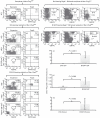The roles of antigen-specificity, responsiveness to transforming growth factor-β and antigen-presenting cell subsets in tumour-induced expansion of regulatory T cells
- PMID: 20722761
- PMCID: PMC2999806
- DOI: 10.1111/j.1365-2567.2010.03328.x
The roles of antigen-specificity, responsiveness to transforming growth factor-β and antigen-presenting cell subsets in tumour-induced expansion of regulatory T cells
Abstract
In this study we investigated the impact of several factors on the expansion of natural regulatory T (nTreg) cells by tumours, including antigen specificity, transforming growth factor-β (TGF-β) signalling and the antigen-presenting cell subsets responsible for expansion. We found that antigen non-specific expansion of nTreg cells is tumour cell line-dependent. Although both antigen-specific and non-specific pathways can contribute to expansion, the migration of activated nTreg cells to tumour tissues is strictly antigen-dependent. Intact TGF-β signalling on nTreg cells is also essential for tumour-induced expansion. Finally, for stimulation of resting antigen-specific CD4 T cells, CD11c(+) cells purified from tumour-draining lymph nodes were more potent than CD11b(+) cells, suggesting that dendritic cells are the key antigen-presenting cell subset involved in cross-presentation of tumour antigens. This study not only provides an in vivo system in which cross-talk between nTreg cells and tumours can be explored but also reveals novel aspects of tumour immune evasion.
© 2010 The Authors. Immunology © 2010 Blackwell Publishing Ltd.
Figures







Similar articles
-
Transforming growth factor-beta1 immobilises dendritic cells within skin tumours and facilitates tumour escape from the immune system.Cancer Immunol Immunother. 2005 Sep;54(9):898-906. doi: 10.1007/s00262-004-0652-3. Epub 2005 Mar 18. Cancer Immunol Immunother. 2005. PMID: 15776284 Free PMC article.
-
Mesenteric lymph node CD11b- CD103+ PD-L1High dendritic cells highly induce regulatory T cells.Immunology. 2017 Sep;152(1):52-64. doi: 10.1111/imm.12747. Epub 2017 Jun 1. Immunology. 2017. PMID: 28423181 Free PMC article.
-
Recipient myeloid-derived immunomodulatory cells induce PD-1 ligand-dependent donor CD4+Foxp3+ regulatory T cell proliferation and donor-recipient immune tolerance after murine nonmyeloablative bone marrow transplantation.J Immunol. 2013 Dec 1;191(11):5764-76. doi: 10.4049/jimmunol.1302191. Epub 2013 Nov 4. J Immunol. 2013. PMID: 24190658 Free PMC article.
-
Regulatory T cell: a protection for tumour cells.J Cell Mol Med. 2012 Mar;16(3):425-36. doi: 10.1111/j.1582-4934.2011.01437.x. J Cell Mol Med. 2012. PMID: 21895966 Free PMC article. Review.
-
Manipulation of regulatory T cells and antigen-specific cytotoxic T lymphocyte-based tumour immunotherapy.Immunology. 2015 Feb;144(2):186-96. doi: 10.1111/imm.12387. Immunology. 2015. PMID: 25243729 Free PMC article. Review.
Cited by
-
The desmoplastic stroma plays an essential role in the accumulation and modulation of infiltrated immune cells in pancreatic adenocarcinoma.Clin Dev Immunol. 2011;2011:212810. doi: 10.1155/2011/212810. Epub 2011 Dec 6. Clin Dev Immunol. 2011. PMID: 22190968 Free PMC article.
-
Modulation of tumor immunity by soluble and membrane-bound molecules at the immunological synapse.Clin Dev Immunol. 2013;2013:450291. doi: 10.1155/2013/450291. Epub 2013 Mar 7. Clin Dev Immunol. 2013. PMID: 23533456 Free PMC article. Review.
-
Distinct in vivo CD8 and CD4 T cell responses against normal and malignant tissues.Cancer Immunol Immunother. 2013 Jan;62(1):101-12. doi: 10.1007/s00262-012-1316-3. Epub 2012 Jul 18. Cancer Immunol Immunother. 2013. PMID: 22806093 Free PMC article.
-
A new target of radiotherapy combined with immunotherapy: regulatory T cells.Front Immunol. 2024 Jan 8;14:1330099. doi: 10.3389/fimmu.2023.1330099. eCollection 2023. Front Immunol. 2024. PMID: 38259489 Free PMC article. Review.
-
Blocking retinoic acid receptor-α enhances the efficacy of a dendritic cell vaccine against tumours by suppressing the induction of regulatory T cells.Cancer Immunol Immunother. 2013 Jul;62(7):1273-82. doi: 10.1007/s00262-013-1432-8. Epub 2013 May 9. Cancer Immunol Immunother. 2013. PMID: 23657628 Free PMC article.
References
-
- Sakaguchi S, Sakaguchi N, Asano M, Itoh M, Toda M. Immunologic self-tolerance maintained by activated T cells expressing IL-2 receptor alpha-chains (CD25). Breakdown of a single mechanism of self-tolerance causes various autoimmune diseases. J Immunol. 1995;155:1151–64. - PubMed
-
- Kohm AP, McMahon JS, Podojil JR, Begolka WS, DeGutes M, Kasprowicz DJ, Ziegler SF, Miller SD. Cutting edge: anti-CD25 monoclonal antibody injection results in the functional inactivation, not depletion, of CD4+ CD25+ T regulatory cells. J Immunol. 2006;176:3301–5. - PubMed
-
- Kim JM, Rasmussen JP, Rudensky AY. Regulatory T cells prevent catastrophic autoimmunity throughout the lifespan of mice. Nat Immunol. 2007;8:191–7. - PubMed
-
- Shimizu J, Yamazaki S, Sakaguchi S. Induction of tumor immunity by removing CD25+ CD4+ T cells: a common basis between tumor immunity and autoimmunity. J Immunol. 1999;163:5211–8. - PubMed
Publication types
MeSH terms
Substances
Grants and funding
LinkOut - more resources
Full Text Sources
Other Literature Sources
Research Materials

